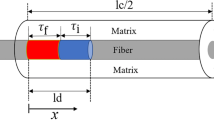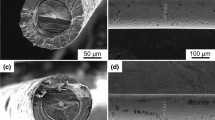Abstract
Micromechanisms influencing crack propagation in a unidirectional SiC-fiber (SCS-8) continuously reinforced Al-Mg-Si 6061 alloy metal-matrix composite (SiCf/Al-6061) during monotonie and cyclic loading are examined at room temperature, both for the longitudinal (0 deg or L-T) and transverse (90 deg or T-L) orientations. It is found that the composite is insensitive to the presence of notches in the L-T orientation under pure tension loading due to the weak fiber/matrix interface; notched failure strengths are ∼1500 MPa compared to 124 MPa for unreinforced 6061. However, behavior is strongly dependent on loading configuration, specimen geometry, and orientation. Specifically, properties in SiCf/Al in the T-L orientation are inferior to unreinforced 6061, although the composite does exhibit increasing crack-growth resistance with crack extension (resistance-curve behavior) under monotonie loading; peak toughnesses of ∼16 MPa√m are achieved due to crack bridging by the continuous metal phase between fibers and residual plastic deformation in the crack wake. In contrast, such bridging is minimal under cyclic loading, as the ductile phase fails subcritically by fatigue such that the transverse fatigue crack-growth resistance is superior in the unreinforced alloy, particularly at high stress-intensity levels. Conversely, fatigue cracks are bridged by unbroken SiC fibers in the L-T orientation and exhibit marked crack deflection and branching; the fatigue crack-growth resistance in this orientation is clearly superior in the composite.
Similar content being viewed by others
References
InMetal Matrix Composites: Mechanisms and Properties, R.K. Everett and R.J. Arsenault, eds., Academic Press, New York, NY, 1991.
S.V. Nair, J.K. Tien, and R.C. Bates:Int. Met. Rev., 1985, vol. 30, pp. 275–90.
J.E. King:Met. Mater., 1989, vol. 5, pp. 720–25.
E.A. Feest:Met. Mater., 1988, vol. 4, pp. 273–78.
K.J. Bhansali and R. Mehrabian:J. Met., 1982, vol. 34 (9), pp. 30–34.
A.P. Divecha, S.G. Fishman, and S.D. Karmarkar:J. Met., 1981, vol. 33 (9), pp. 12–17.
M. Manoharan and J.J. Lewandowski:Acta Metall., 1990, vol. 38, pp. 489–96.
S.V. Kamat, J.P. Hirth, and R. Mehrabian:Acta Metall., 1989, vol. 39, pp. 2395–402.
Y. Flom and R.J. Arsenault:Acta Metall., 1989, vol. 37, pp. 2413–23.
J. Stephens, J.P. Lucas, and F.M. Hosking:Scripta Metall., 1988, vol. 22, pp. 1307–12.
C.R. Saff, D.M. Harmon, and W.S. Johnson:J. Met., 1988, vol. 40(11), pp. 58–63.
W.S. Johnson: inMetal Matrix Composites: Testing, Analysis and Failure Modes, ASTM STP 1032, W.S. Johnson, ed., ASTM, Philadelphia, PA, 1989, pp. 194–221.
W.S. Johnson and R. R. Walls: inComposite Materials: Fatigue and Fradure, ASTM STP 907, H.T. Hahn, ed., ASTM, Philadelphia, PA, 1986, pp. 161–75.
Y.H. Park, D. Narayen, M. Schmerling, and H.L. Marcus:J. Mater. Sci., 1984, vol. 19, pp. 2239–45.
P. Soumelidis, J.M. Quenisset, R. Naslain, and N.S. Stoloff:J. Mater. Sci., 1986, vol. 21, pp. 895–903.
K.S. Chan and D.L. Davidson:Metall. Trans. A, 1990, vol. 21A, pp. 1603–12.
D.L. Davidson, K.S. Chan, A. McMinn, and G.R. Leverant:Metall. Trans. A, 1989, vol. 20A, pp. 2369–78.
D. Walls, G. Bao, and F. Zok: inFatigue of Advanced Materials, R.O. Ritchie, R.H. Dauskardt, and B.N. Cox, eds., Materials and Component Engineering Publ. Ltd., Birmingham, United Kingdom, 1991, pp. 343–56.
P. Kantzos, J. Telesman, and L. Ghosn: inComposite Materials: Fatigue and Fracture, ASTM STP 1110, T.K. O’Brien, ed., ASTM, Philadelphia, PA, 1991, vol. III, pp. 711–31.
R. John and N.E. Ashbaugh: inTitanium Aluminide Composites, P.R. Smith, S.J. Balsone, and T. Nicholas, eds., Materials Directorate, Wright Laboratory, Wright-Patterson Air Force Base, OH, 1991, pp. 497–510.
B.N. Cox, M.S. Dadkhah, M.R. James, D.B. Marshall, W.L. Morris, and M. Shaw:Acta Metall., 1990, vol. 38, pp. 2425–33.
A.G. Evans and D.B. Marshall:Acta Metall., 1989, vol. 37, pp. 2567–83.
Anon:Continuous Silicon Carbide Metal Matrix Composites, Textron Specialty Materials, Lowell, MA, 1992.
V. Laurent, D. Chatain, and N. Eustathopoulos:J. Mater. Sci., 1987, vol. 22, pp. 244–50.
B. Budiansky, J.W. Hutchinson, and A.G. Evans:J. Mech. Phys. Sol., 1986, vol. 34, pp. 167–89.
S. Jansson, H.E. Dève, and A.G. Evans:Metall. Trans. A, 1991, vol. 22A, pp. 2975–84.
Y. Flom and R.J. Arsenault:Mater. Sci. Eng., 1976, vol. 77, pp. 191–97.
R.H. Dauskardt and R.O. Ritchie:Closed Loop, 1989, vol. 27, pp. 7–17.
Anon:Metals Handbook, 9th ed., ASTM, Metals Park, OH, 1985, vol. 8, pp. 376-402.
R.O. Ritchie, W. Yu, and R.J. Bucci:Eng. Fract. Mech., 1989, vol. 32, pp. 361–77.
O.L. Bowie and C.E. Freese:Int. J. Fract., 1972, vol. 8, pp. 49–58.
J.G. Williams: inApplication of Fracture Mechanics to Composite Materials, K. Friedrich, ed., Elsevier, New York, NY, 1989, pp. 3–38.
Z. Suo and J.W. Hutchinson:Mater. Sci. Eng., 1989, vol. A107, pp. 135–43.
H. Tada, P.C. Paris, and G.R. Irwin:The Stress Analysis of Cracks Handbook, Del Research, St. Louis, MO, 1985.
D.B. Marshall, W.L. Morris, B.N. Cox, and M.S. Dadkhah:J. Am. Ceram. Soc, 1990, vol. 73, pp. 2938–43.
J.R. Rice:J. Appl. Mech., 1988, vol. 55, pp. 98–103.
K.T. Venkateswara Rao, G. R. Odette, and R.O. Ritchie:Acta Metall. Mater., 1992, vol. 40, pp. 353–61.
Author information
Authors and Affiliations
Rights and permissions
About this article
Cite this article
Rao, K.T.V., Siu, S.C. & Ritchie, R.O. Failure mechanisms in SiC-fiber reinforced 6061 aluminum alloy composites under monotonic and cyclic loading. Metall Trans A 24, 721–734 (1993). https://doi.org/10.1007/BF02656640
Received:
Issue Date:
DOI: https://doi.org/10.1007/BF02656640




